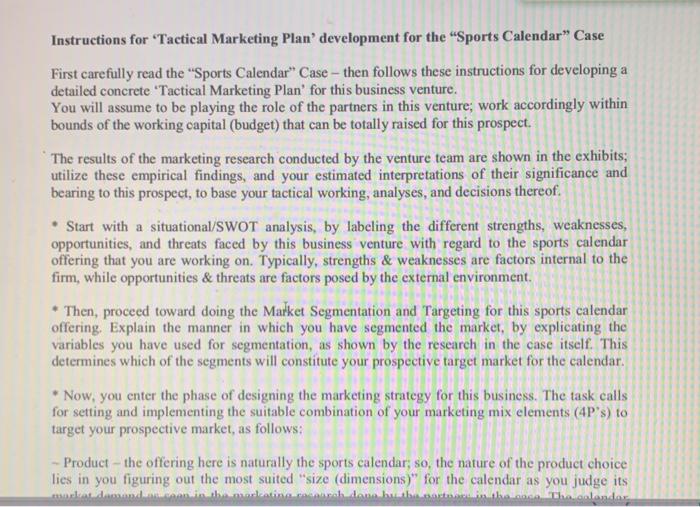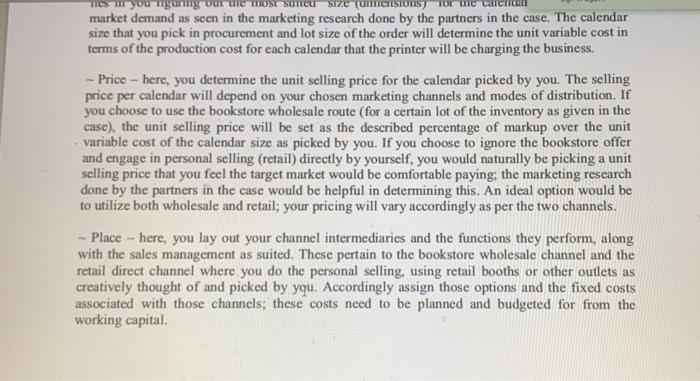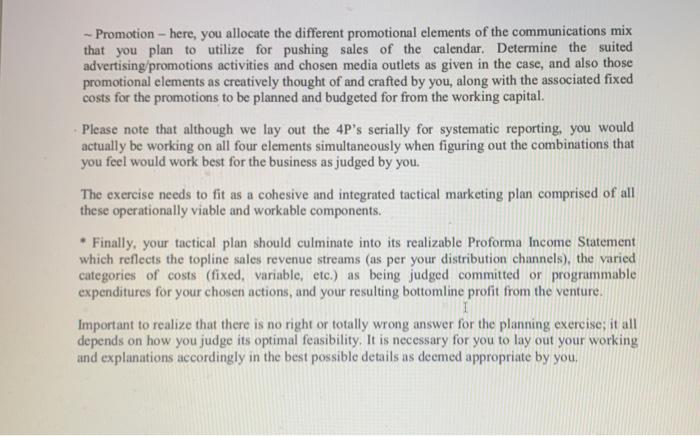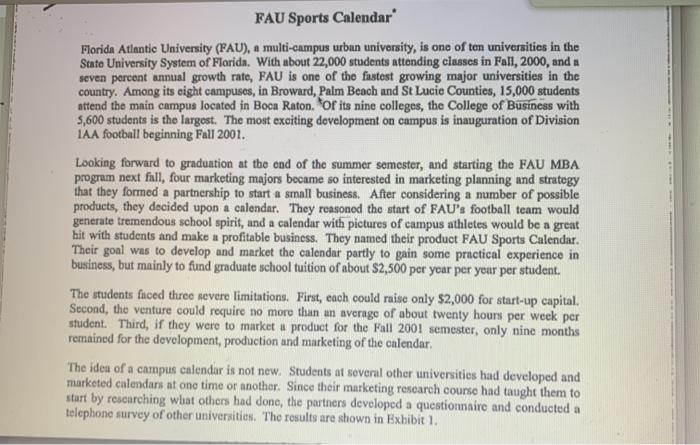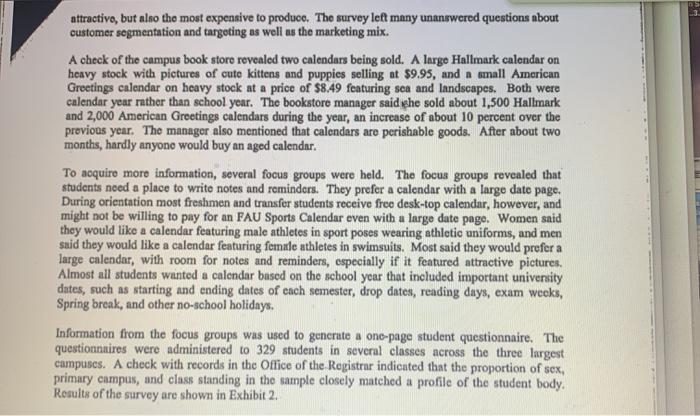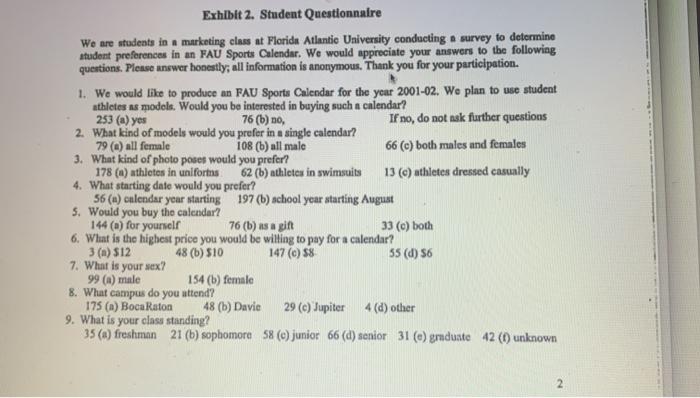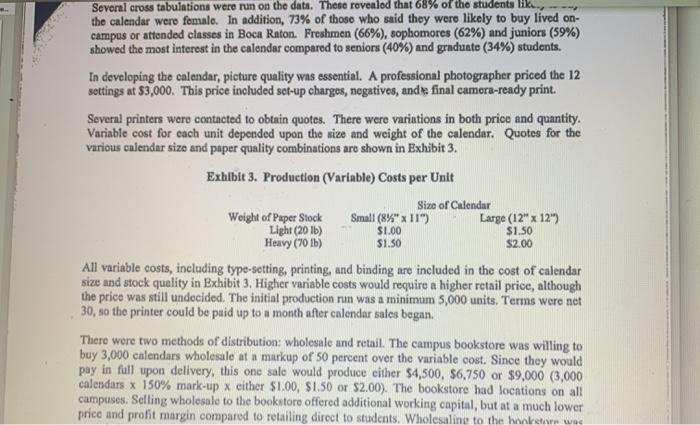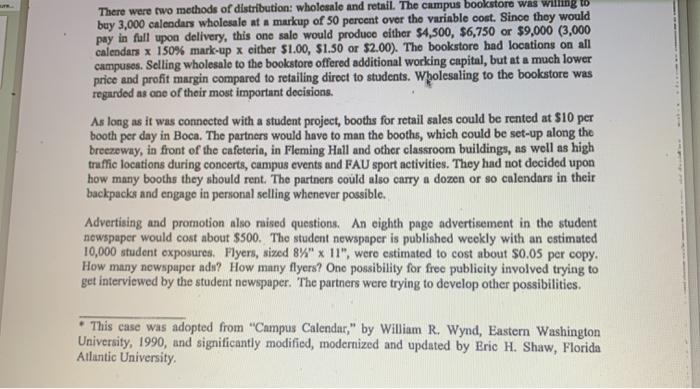Instructions for Tactical Marketing Plan development for the "Sports Calendar" Case First carefully read the "Sports Calendar Case - then follows these instructions for developing a detailed concrete "Tactical Marketing Plan' for this business venture. You will assume to be playing the role of the partners in this venture; work accordingly within bounds of the working capital (budget) that can be totally raised for this prospect. The results of the marketing research conducted by the venture team are shown in the exhibits; utilize these empirical findings, and your estimated interpretations of their significance and bearing to this prospect, to base your tactical working, analyses, and decisions thereof. * Start with a situational/SWOT analysis, by labeling the different strengths, weaknesses, opportunities, and threats faced by this business venture with regard to the sports calendar offering that you are working on. Typically, strengths & weaknesses are factors internal to the firm, while opportunities & threats are factors posed by the external environment. * Then, proceed toward doing the Market Segmentation and Targeting for this sports calendar offering. Explain the manner in which you have segmented the market, by explicating the variables you have used for segmentation, as shown by the research in the case itself. This determines which of the segments will constitute your prospective target market for the calendar. Now, you enter the phase of designing the marketing strategy for this business. The task calls for setting and implementing the suitable combination of your marketing mix elements (4P's) to target your prospective market, as follows: - Product - the offering here is naturally the sports calendar, so, the nature of the product choice lies in you figuring out the most suited size (dimensions)" for the calendar as you judge its that ha olander bahan Test your gungout IC Most Sumcu SIZE (CTTTTTISTO T01 we market demand as seen in the marketing research done by the partners in the case. The calendar size that you pick in procurement and lot size of the order will determine the unit variable cost in terms of the production cost for each calendar that the printer will be charging the business. - Price - here, you determine the unit selling price for the calendar picked by you. The selling price per calendar will depend on your chosen marketing channels and modes of distribution. If you choose to use the bookstore wholesale route (for a certain lot of the inventory as given in the case), the unit selling price will be set as the described percentage of markup over the unit variable cost of the calendar size as picked by you. If you choose to ignore the bookstore offer and engage in personal selling (retail) directly by yourself, you would naturally be picking a unit selling price that you feel the target market would be comfortable paying; the marketing research done by the partners in the case would be helpful in determining this. An ideal option would be to utilize both wholesale and retail; your pricing will vary accordingly as per the two channels. - Place - here, you lay out your channel intermediaries and the functions they perform, along with the sales management as suited. These pertain to the bookstore wholesale channel and the retail direct channel where you do the personal selling, using retail booths or other outlets as creatively thought of and picked by you. Accordingly assign those options and the fixed costs associated with those channels, these costs need to be planned and budgeted for from the working capital - Promotion - here, you allocate the different promotional elements of the communications mix that you plan to utilize for pushing sales of the calendar. Determine the suited advertising/promotions activities and chosen media outlets as given in the case, and also those promotional elements as creatively thought of and crafted by you, along with the associated fixed costs for the promotions to be planned and budgeted for from the working capital. Please note that although we lay out the 4P's serially for systematic reporting, you would actually be working on all four elements simultaneously when figuring out the combinations that you feel would work best for the business as judged by you. The exercise needs to fit as a cohesive and integrated tactical marketing plan comprised of all these operationally viable and workable components. Finally, your tactical plan should culminate into its realizable Proforma Income Statement which reflects the topline sales revenue streams (as per your distribution channels), the varied categories of costs (fixed, variable, etc.) as being judged committed or programmable expenditures for your chosen actions, and your resulting bottomline profit from the venture. I Important to realize that there is no right or totally wrong answer for the planning exercise; it all depends on how you judge its optimal feasibility. It is necessary for you to lay out your working and explanations accordingly in the best possible details as deemed appropriate by you. FAU Sports Calendar Florida Atlantic University (FAU), a multi-campus urban university, is one of ten universities in the State University System of Florida. With about 22,000 students attending classes in Fall, 2000, and a seven percent annual growth rate, FAU is one of the fastest growing major universities in the country. Among its eight campuses, in Broward, Palm Beach and St Lucic Counties, 15,000 students attend the main campus located in Boca Raton of its nine colleges, the College of Business with 5,600 students is the largest. The most exciting development on campus is inauguration of Division 1AA football beginning Fall 2001. Looking forward to graduation at the end of the summer semester, and starting the FAU MBA program next fall, four marketing majors became so interested in marketing planning and strategy that they formed a partnership to start a small business. After considering a number of possible products, they decided upon a calendar. They reasoned the start of FAU's football team would generate tremendous school spirit, and a calendar with pictures of campus athletes would be a great hit with students and make a profitable business. They named their product FAU Sports Calendar. Their goal was to develop and market the calendar partly to gain some practical experience in business, but mainly to fund graduate school tuition of about $2,500 per year per year per student. The students faced three severe limitations. First, each could raise only $2,000 for start-up cupital. Second, the venture could require no more than an average of about twenty hours per week per student. Third, if they were to market a product for the Fall 2001 semester, only nine months remained for the development, production and marketing of the calendar. The ideu of a campus calendar is not new. Students at several other universities had developed and marketed calendars at one time or another. Since their marketing research course had taught them to start by researching what others had done, the partners developed a questionnaire and conducted a telephone survey of other universities. The results are shown in Exhibit 1. U of C Exhibit 1. Other Campus Calendars Selected Questions U of M Uoro Uoft 1. Size of Market 18,000 32,000 28,000 2. Calendar size 8%" x 11" -12" x 12" 8%" x 11" 3. Paper Stock: 'Heavy, Light H L L 4. What year: Calendar, School 8 8 4. Type Calendar: F B Male, Female, Both Swimsuit Fully clothed Campus scenes 5. Selling Price 57.00 $5.95 $9.95 6. Distribution: Retail, Wholesale, Both Retail Both Retail 7. Unit Sales 5,000 9,000 4,000 36,000 12" x 12" H S F-swimsuit M-head 58.00 Both 7,000 Based upon the survey results, the students concluded that quality was particularly important. Visual inspection of sample calendars sent by the survey respondents emphasized that the quality of printing, paper, and photography contributed greatly to the product image. The size of the calendar varied from a folded size of 8%" X 11", which was considered srnall, to 12" X 12", which was considered large. The large size calendar produced at U of C on heavyweight stock was the most W attractivo, but also the most expensive to produce. The survey left many unanswered questions about customer segmentation and targeting as well as the marketing mix. A check of the campus book store revealed two calendars being sold. A large Hallmark calendar on heavy stock with pictures of cute kittens and puppies selling at $9.95, and a small American Greetings calendar on heavy stock at a price of $8.49 featuring sea and landscapes. Both were calendar year rather than school year. The bookstore manager said she sold about 1,500 Hallmark and 2,000 American Greetings calendars during the year, an increase of about 10 percent over the previous year. The manager also mentioned that calendars are perishable goods. After about two months, hardly anyone would buy an aged calendar. To acquire more information, several focus groups were held. The focus groups revealed that students need a place to write notes and reminders. They prefer a calendar with a large date page. During orientation most freshmen and transfer students receive free desk-top calendar, however, and might not be willing to pay for an FAU Sports Calendar even with a large date page. Women said they would like a calendar featuring male athletes in sport poses wearing athletic uniforms, and men said they would like a calendar featuring female athletes in swimsuits. Most said they would prefer a large calendar, with room for notes and reminders, especially if it featured attractive pictures, Almost all students wanted a calendar based on the school year that included important university dates, such as starting and ending dates of each semester, drop dates, reading days, exam weeks, Spring break, and other no-school holidays. Information from the focus groups was used to generate a one-page student questionnaire. The questionnaires were administered to 329 students in several classes across the three largest campuscs. A check with records in the Office of the Registrar indicated that the proportion of sex, primary campus, and class standing in the sample closely matched a profile of the student body. Results of the survey are shown in Exhibit 2. Exhibit 2. Student Questionnaire We are students in a marketing class at Florida Atlantic University conducting a survey to determine student preferences in an FAU Sports Calendar. We would appreciate your answers to the following questions. Please answer honestly, all information is anonymous. Thank you for your participation. 1. We would like to produce an FAU Sports Calendar for the your 2001-02. We plan to use student athletes as models. Would you be interested in buying such a calendar? 253 (a) yes 76 (b) no, If no, do not ask further questions 2. What kind of models would you prefer in a single calendar? 79 (6) all female 108 (b) all male 66 (e) both mules and females 3. What kind of photo poses would you prefer? 178 (a) athletes in un fortes 62 (b) athletes in swimsuits 13 () athletes dressed casually 4. What starting date would you prefer? 56 (a) calendar year starting 197 (b) school year starting August 5. Would you buy the calendar? 144 (a) for yourself 76 (b) as a gift 33 (c) both 6. What is the highest price you would be willing to pay for a calendar? 3(a) S12 48 (6) 510 147 (c) $8 55 (d) 56 7. What is your sex? 99 (a) male 154 (b) female 8. What campus do you attend? 175 (a) Boca Raton 48 (b) Davie 29 (e) Jupiter 4(d) other 9. What is your class standing? 35 (a) freshman 21 (b) sophomore 58 (c) junior 66 (d) senior 31 (6) graduate 42 (1) unknown Several cross tabulations were run on the data. These revealed that 68% of the students like the calendar were femalo. In addition, 73% of those who said they were likely to buy lived on- campus or attended classes in Boca Raton. Freshmen (66%), sophomores (62%) and juniors (59%) showed the most interest in the calendar compared to seniors (40%) and graduato (34%) students. In developing the calendar, picture quality was essential. A professional photographer priced the 12 settings at $3,000. This price included set-up chargos, negatives, and final camera-ready print. Several printers were contacted to obtain quotes. There were variations in both price and quantity. Variable cost for each unit depended upon the size and weight of the calendar. Quotes for the various calendar size and paper quality combinations are shown in Exhibit 3. Exhibit 3. Production (Variable) Costs per Unit Size of Calendar Weight of Paper Stock Small (8%" x 11") Large (12" X 12") Light (20 lb) $1.00 $1.50 Heavy (70 lb) $1.50 $2.00 All variable costs, including type-setting, printing, and binding are included in the cost of calendar size and stock quality in Exhibit 3. Higher variable costs would require a higher retail price, although the price was still undecided. The initial production run was a minimum 5,000 units. Terms were not 30, so the printer could be paid up to a month after calendar sales began. There were two methods of distribution: wholesale and retail. The campus bookstore was willing to buy 3,000 calendars wholesale at a markup of 50 percent over the variable cost. Since they would pay in full upon delivery, this one sale would produce either $4,500, $6,750 or $9,000 (3,000 calendars x 150% mark-up x either $1.00, $1.50 or $2.00). The bookstore had locations on all campuses. Selling wholesale to the bookstore offered additional working capital, but at a much lower price and profit margin compared to retailing direct to students. Wholesaling to the hooketom was There were two methods of distribution: Wholesale and retail. The campus bookstore was willing buy 3,000 calendars wholesale at a markup of 50 percent over the variable cost. Since they would pay in full upon delivery, this one sale would produce either $4,500, $6,750 or $9.000 (3,000 calendars x 150% mark-up x either $1.00, $1.50 or $2.00). The bookstore had locations on all campuses. Selling wholesale to the bookstore offered additional working capital, but at a much lower price and profit margin compared to retailing direct to students. Wholesaling to the bookstore was regarded as one of their most important decisions. As long as it was connected with a student project, booths for retail sales could be rented at $10 per booth per day in Boca. The partners would have to man tho booths, which could be set-up along the breezeway, in front of the cafeterin, in Fleming Hall and other classroom buildings, as well as high traffic locations during concerts, campus events and FAU sport activities. They had not decided upon how many booths they should rent. The partners could also carry a dozen or so calendars in their backpacks and engage in personal selling whenever possible. Advertising and promotion also raised questions. An eighth page advertisement in the student newspaper would cost about $500. The student newspaper is published weekly with an estimated 10,000 student exposures, Flyers, sized 8%" x 11", were estimated to cost about $0.05 per copy. How many newspaper ads? How many flyers? Ono possibility for free publicity involved trying to get interviewed by the student newspaper. The partners were trying to develop other possibilities This case was adopted from "Campus Calendar," by William R. Wynd, Eastern Washington University, 1990, and significantly modified, modernized and updated by Eric H. Shaw, Florida Atlantic University Instructions for Tactical Marketing Plan development for the "Sports Calendar" Case First carefully read the "Sports Calendar Case - then follows these instructions for developing a detailed concrete "Tactical Marketing Plan' for this business venture. You will assume to be playing the role of the partners in this venture; work accordingly within bounds of the working capital (budget) that can be totally raised for this prospect. The results of the marketing research conducted by the venture team are shown in the exhibits; utilize these empirical findings, and your estimated interpretations of their significance and bearing to this prospect, to base your tactical working, analyses, and decisions thereof. * Start with a situational/SWOT analysis, by labeling the different strengths, weaknesses, opportunities, and threats faced by this business venture with regard to the sports calendar offering that you are working on. Typically, strengths & weaknesses are factors internal to the firm, while opportunities & threats are factors posed by the external environment. * Then, proceed toward doing the Market Segmentation and Targeting for this sports calendar offering. Explain the manner in which you have segmented the market, by explicating the variables you have used for segmentation, as shown by the research in the case itself. This determines which of the segments will constitute your prospective target market for the calendar. Now, you enter the phase of designing the marketing strategy for this business. The task calls for setting and implementing the suitable combination of your marketing mix elements (4P's) to target your prospective market, as follows: - Product - the offering here is naturally the sports calendar, so, the nature of the product choice lies in you figuring out the most suited size (dimensions)" for the calendar as you judge its that ha olander bahan Test your gungout IC Most Sumcu SIZE (CTTTTTISTO T01 we market demand as seen in the marketing research done by the partners in the case. The calendar size that you pick in procurement and lot size of the order will determine the unit variable cost in terms of the production cost for each calendar that the printer will be charging the business. - Price - here, you determine the unit selling price for the calendar picked by you. The selling price per calendar will depend on your chosen marketing channels and modes of distribution. If you choose to use the bookstore wholesale route (for a certain lot of the inventory as given in the case), the unit selling price will be set as the described percentage of markup over the unit variable cost of the calendar size as picked by you. If you choose to ignore the bookstore offer and engage in personal selling (retail) directly by yourself, you would naturally be picking a unit selling price that you feel the target market would be comfortable paying; the marketing research done by the partners in the case would be helpful in determining this. An ideal option would be to utilize both wholesale and retail; your pricing will vary accordingly as per the two channels. - Place - here, you lay out your channel intermediaries and the functions they perform, along with the sales management as suited. These pertain to the bookstore wholesale channel and the retail direct channel where you do the personal selling, using retail booths or other outlets as creatively thought of and picked by you. Accordingly assign those options and the fixed costs associated with those channels, these costs need to be planned and budgeted for from the working capital - Promotion - here, you allocate the different promotional elements of the communications mix that you plan to utilize for pushing sales of the calendar. Determine the suited advertising/promotions activities and chosen media outlets as given in the case, and also those promotional elements as creatively thought of and crafted by you, along with the associated fixed costs for the promotions to be planned and budgeted for from the working capital. Please note that although we lay out the 4P's serially for systematic reporting, you would actually be working on all four elements simultaneously when figuring out the combinations that you feel would work best for the business as judged by you. The exercise needs to fit as a cohesive and integrated tactical marketing plan comprised of all these operationally viable and workable components. Finally, your tactical plan should culminate into its realizable Proforma Income Statement which reflects the topline sales revenue streams (as per your distribution channels), the varied categories of costs (fixed, variable, etc.) as being judged committed or programmable expenditures for your chosen actions, and your resulting bottomline profit from the venture. I Important to realize that there is no right or totally wrong answer for the planning exercise; it all depends on how you judge its optimal feasibility. It is necessary for you to lay out your working and explanations accordingly in the best possible details as deemed appropriate by you. FAU Sports Calendar Florida Atlantic University (FAU), a multi-campus urban university, is one of ten universities in the State University System of Florida. With about 22,000 students attending classes in Fall, 2000, and a seven percent annual growth rate, FAU is one of the fastest growing major universities in the country. Among its eight campuses, in Broward, Palm Beach and St Lucic Counties, 15,000 students attend the main campus located in Boca Raton of its nine colleges, the College of Business with 5,600 students is the largest. The most exciting development on campus is inauguration of Division 1AA football beginning Fall 2001. Looking forward to graduation at the end of the summer semester, and starting the FAU MBA program next fall, four marketing majors became so interested in marketing planning and strategy that they formed a partnership to start a small business. After considering a number of possible products, they decided upon a calendar. They reasoned the start of FAU's football team would generate tremendous school spirit, and a calendar with pictures of campus athletes would be a great hit with students and make a profitable business. They named their product FAU Sports Calendar. Their goal was to develop and market the calendar partly to gain some practical experience in business, but mainly to fund graduate school tuition of about $2,500 per year per year per student. The students faced three severe limitations. First, each could raise only $2,000 for start-up cupital. Second, the venture could require no more than an average of about twenty hours per week per student. Third, if they were to market a product for the Fall 2001 semester, only nine months remained for the development, production and marketing of the calendar. The ideu of a campus calendar is not new. Students at several other universities had developed and marketed calendars at one time or another. Since their marketing research course had taught them to start by researching what others had done, the partners developed a questionnaire and conducted a telephone survey of other universities. The results are shown in Exhibit 1. U of C Exhibit 1. Other Campus Calendars Selected Questions U of M Uoro Uoft 1. Size of Market 18,000 32,000 28,000 2. Calendar size 8%" x 11" -12" x 12" 8%" x 11" 3. Paper Stock: 'Heavy, Light H L L 4. What year: Calendar, School 8 8 4. Type Calendar: F B Male, Female, Both Swimsuit Fully clothed Campus scenes 5. Selling Price 57.00 $5.95 $9.95 6. Distribution: Retail, Wholesale, Both Retail Both Retail 7. Unit Sales 5,000 9,000 4,000 36,000 12" x 12" H S F-swimsuit M-head 58.00 Both 7,000 Based upon the survey results, the students concluded that quality was particularly important. Visual inspection of sample calendars sent by the survey respondents emphasized that the quality of printing, paper, and photography contributed greatly to the product image. The size of the calendar varied from a folded size of 8%" X 11", which was considered srnall, to 12" X 12", which was considered large. The large size calendar produced at U of C on heavyweight stock was the most W attractivo, but also the most expensive to produce. The survey left many unanswered questions about customer segmentation and targeting as well as the marketing mix. A check of the campus book store revealed two calendars being sold. A large Hallmark calendar on heavy stock with pictures of cute kittens and puppies selling at $9.95, and a small American Greetings calendar on heavy stock at a price of $8.49 featuring sea and landscapes. Both were calendar year rather than school year. The bookstore manager said she sold about 1,500 Hallmark and 2,000 American Greetings calendars during the year, an increase of about 10 percent over the previous year. The manager also mentioned that calendars are perishable goods. After about two months, hardly anyone would buy an aged calendar. To acquire more information, several focus groups were held. The focus groups revealed that students need a place to write notes and reminders. They prefer a calendar with a large date page. During orientation most freshmen and transfer students receive free desk-top calendar, however, and might not be willing to pay for an FAU Sports Calendar even with a large date page. Women said they would like a calendar featuring male athletes in sport poses wearing athletic uniforms, and men said they would like a calendar featuring female athletes in swimsuits. Most said they would prefer a large calendar, with room for notes and reminders, especially if it featured attractive pictures, Almost all students wanted a calendar based on the school year that included important university dates, such as starting and ending dates of each semester, drop dates, reading days, exam weeks, Spring break, and other no-school holidays. Information from the focus groups was used to generate a one-page student questionnaire. The questionnaires were administered to 329 students in several classes across the three largest campuscs. A check with records in the Office of the Registrar indicated that the proportion of sex, primary campus, and class standing in the sample closely matched a profile of the student body. Results of the survey are shown in Exhibit 2. Exhibit 2. Student Questionnaire We are students in a marketing class at Florida Atlantic University conducting a survey to determine student preferences in an FAU Sports Calendar. We would appreciate your answers to the following questions. Please answer honestly, all information is anonymous. Thank you for your participation. 1. We would like to produce an FAU Sports Calendar for the your 2001-02. We plan to use student athletes as models. Would you be interested in buying such a calendar? 253 (a) yes 76 (b) no, If no, do not ask further questions 2. What kind of models would you prefer in a single calendar? 79 (6) all female 108 (b) all male 66 (e) both mules and females 3. What kind of photo poses would you prefer? 178 (a) athletes in un fortes 62 (b) athletes in swimsuits 13 () athletes dressed casually 4. What starting date would you prefer? 56 (a) calendar year starting 197 (b) school year starting August 5. Would you buy the calendar? 144 (a) for yourself 76 (b) as a gift 33 (c) both 6. What is the highest price you would be willing to pay for a calendar? 3(a) S12 48 (6) 510 147 (c) $8 55 (d) 56 7. What is your sex? 99 (a) male 154 (b) female 8. What campus do you attend? 175 (a) Boca Raton 48 (b) Davie 29 (e) Jupiter 4(d) other 9. What is your class standing? 35 (a) freshman 21 (b) sophomore 58 (c) junior 66 (d) senior 31 (6) graduate 42 (1) unknown Several cross tabulations were run on the data. These revealed that 68% of the students like the calendar were femalo. In addition, 73% of those who said they were likely to buy lived on- campus or attended classes in Boca Raton. Freshmen (66%), sophomores (62%) and juniors (59%) showed the most interest in the calendar compared to seniors (40%) and graduato (34%) students. In developing the calendar, picture quality was essential. A professional photographer priced the 12 settings at $3,000. This price included set-up chargos, negatives, and final camera-ready print. Several printers were contacted to obtain quotes. There were variations in both price and quantity. Variable cost for each unit depended upon the size and weight of the calendar. Quotes for the various calendar size and paper quality combinations are shown in Exhibit 3. Exhibit 3. Production (Variable) Costs per Unit Size of Calendar Weight of Paper Stock Small (8%" x 11") Large (12" X 12") Light (20 lb) $1.00 $1.50 Heavy (70 lb) $1.50 $2.00 All variable costs, including type-setting, printing, and binding are included in the cost of calendar size and stock quality in Exhibit 3. Higher variable costs would require a higher retail price, although the price was still undecided. The initial production run was a minimum 5,000 units. Terms were not 30, so the printer could be paid up to a month after calendar sales began. There were two methods of distribution: wholesale and retail. The campus bookstore was willing to buy 3,000 calendars wholesale at a markup of 50 percent over the variable cost. Since they would pay in full upon delivery, this one sale would produce either $4,500, $6,750 or $9,000 (3,000 calendars x 150% mark-up x either $1.00, $1.50 or $2.00). The bookstore had locations on all campuses. Selling wholesale to the bookstore offered additional working capital, but at a much lower price and profit margin compared to retailing direct to students. Wholesaling to the hooketom was There were two methods of distribution: Wholesale and retail. The campus bookstore was willing buy 3,000 calendars wholesale at a markup of 50 percent over the variable cost. Since they would pay in full upon delivery, this one sale would produce either $4,500, $6,750 or $9.000 (3,000 calendars x 150% mark-up x either $1.00, $1.50 or $2.00). The bookstore had locations on all campuses. Selling wholesale to the bookstore offered additional working capital, but at a much lower price and profit margin compared to retailing direct to students. Wholesaling to the bookstore was regarded as one of their most important decisions. As long as it was connected with a student project, booths for retail sales could be rented at $10 per booth per day in Boca. The partners would have to man tho booths, which could be set-up along the breezeway, in front of the cafeterin, in Fleming Hall and other classroom buildings, as well as high traffic locations during concerts, campus events and FAU sport activities. They had not decided upon how many booths they should rent. The partners could also carry a dozen or so calendars in their backpacks and engage in personal selling whenever possible. Advertising and promotion also raised questions. An eighth page advertisement in the student newspaper would cost about $500. The student newspaper is published weekly with an estimated 10,000 student exposures, Flyers, sized 8%" x 11", were estimated to cost about $0.05 per copy. How many newspaper ads? How many flyers? Ono possibility for free publicity involved trying to get interviewed by the student newspaper. The partners were trying to develop other possibilities This case was adopted from "Campus Calendar," by William R. Wynd, Eastern Washington University, 1990, and significantly modified, modernized and updated by Eric H. Shaw, Florida Atlantic University
